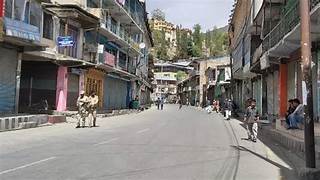
Complete Shutdown in Kargil Following Leh Protests That Killed Four

 :
| Updated On: 25-Sep-2025 @ 12:45 pm
:
| Updated On: 25-Sep-2025 @ 12:45 pmSHARE
Following the tragic events in Leh, where four people were killed during protests demanding statehood for Ladakh and the implementation of Sixth Schedule protections, the neighboring town of Kargil experienced a tense but largely peaceful day on Thursday. Authorities reported that, as of Thursday morning, there had been no incidents of violence since Wednesday evening. Despite the calm, restrictions on public gatherings of four or more people remain in place to prevent any potential escalation of unrest. The administration is closely monitoring the situation to maintain law and order while respecting the residents’ right to protest within permitted limits.
The protests in Leh stemmed from longstanding demands by sections of the Ladakhi population for increased autonomy, recognition, and constitutional safeguards under the Sixth Schedule, which provides special protections for tribal areas in India. These protests turned violent on Wednesday, resulting in the deaths of four individuals. The killings, which occurred during police firing, have intensified feelings of anger and grief in both Leh and surrounding areas, prompting expressions of solidarity across the region. The tragedy has highlighted both the deep-rooted political aspirations of the Ladakhi people and the sensitive nature of law enforcement operations in areas with historical and cultural complexities.
In response to the events in Leh, Kargil observed a complete shutdown on Thursday. This shutdown served both as a protest against the police firing in Leh and as a demonstration of solidarity with the victims’ families and the people of Leh. Residents, businesses, and institutions in Kargil largely adhered to the shutdown, signaling a collective sense of mourning and protest. Public transportation and commercial activity were significantly reduced, reflecting the widespread participation of the local population in this silent demonstration.
The administration in Kargil has proactively prohibited public assemblies to prevent any potential escalation of unrest or clashes. Simultaneously, a substantial number of police and paramilitary personnel have been deployed across the town. Their presence aims to ensure that law and order is maintained, that protests remain peaceful, and that essential services continue without disruption. Authorities have emphasized the importance of restraint on all sides and are engaging in community outreach to communicate the rules and expectations to local residents.
While the immediate focus has been on maintaining calm in Kargil, the events in Leh have sparked wider discussions about governance, autonomy, and the implementation of constitutional protections in Ladakh. Citizens, political leaders, and civil society organizations are closely watching how both local and central authorities respond to the incident. The handling of the protests, the police response, and the subsequent administrative measures in Kargil are being viewed as indicators of how similar situations may be managed in the future.
In conclusion, Thursday in Kargil was marked by a combination of mourning, protest, and heightened security measures. Despite the shadow cast by the tragic deaths in Leh, the town remained largely peaceful, thanks in part to proactive administrative measures, the deployment of security forces, and the cooperation of the local population. The ongoing restrictions on gatherings and the complete shutdown reflect both the seriousness with which authorities are treating the situation and the solidarity of Kargil’s residents with those affected by the events in Leh. Authorities continue to monitor the situation closely to prevent any escalation, while community leaders and citizens navigate the delicate balance between protest, mourning, and maintaining public order.